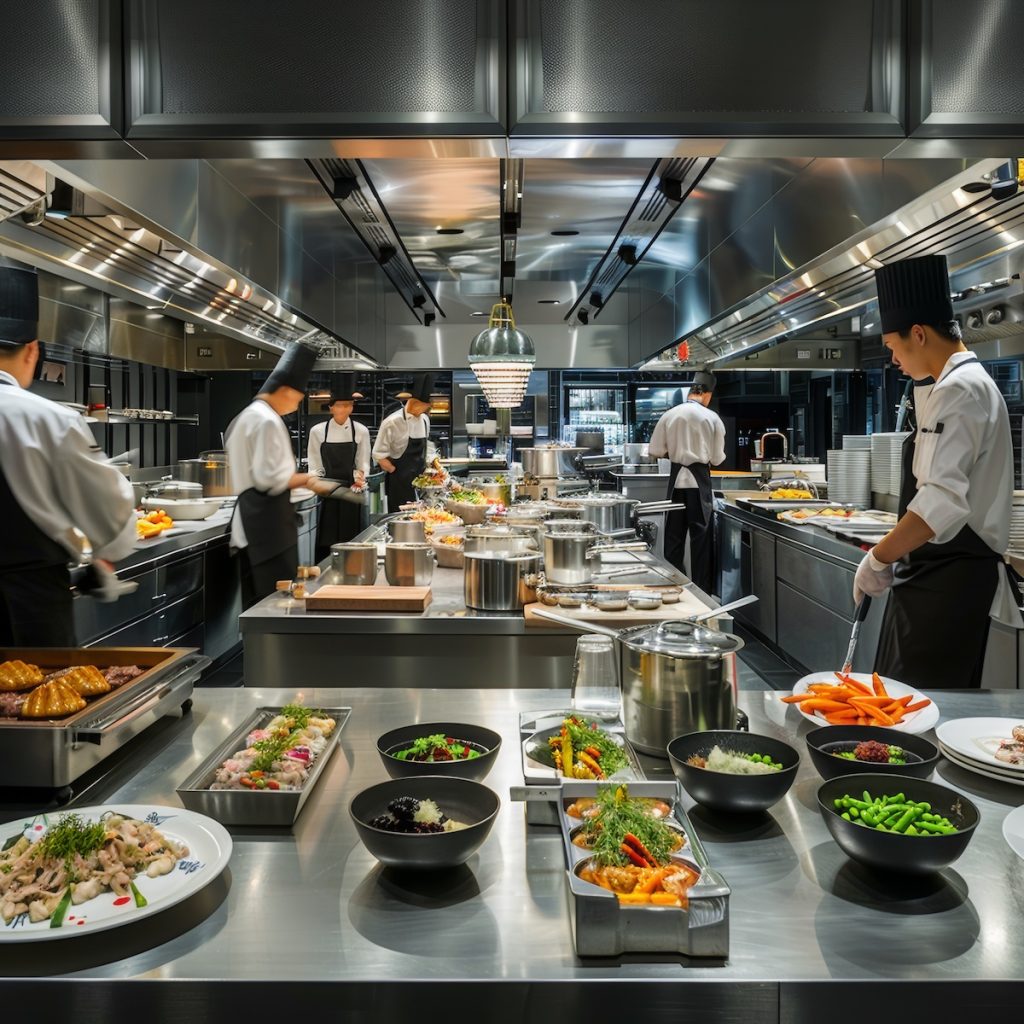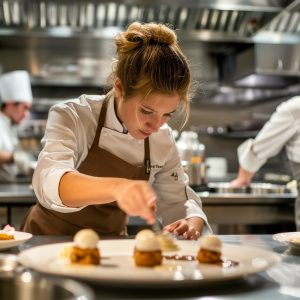The Brigade de Cuisine, Then and Now – Part 2
This is part 2 of a two-part post on Escoffier’s Brigade system of kitchen hierarchy. Part 1 looked at Escoffier’s Brigade de Cuisine back in the day, and this post will look at how it is used today.
As I mentioned in Part 1, this is a good read for anyone interested in getting into the culinary industry or going to a culinary school to be trained as a professional cook. If you are looking for a culinary school, baking and pastry school, or hospitality management program, I recommend you go to the All Schools Page and find a school near you.
The Brigade de Cuisine, Now
In today’s commercial kitchens, cost is king. In many chain restaurants, dishes are created by a corporate chef in a test kitchen, made in a commissary, and only finished on-site. Even in small, independent restaurants, many chefs turn to ready-made or flash-frozen products as they try to balance price and quality.
It is a rare restaurant whose kitchen staff prepares everything from scratch. If you have one of these gems in your neighborhood or town, by all means, show them your support by being regular patrons.
Restaurants do well in areas where a lot of people come. Most of those places are high-rent districts. As a result, leasing the space costs a lot per square foot.
Add on the exorbitant cost of a liquor license (the real money maker at a restaurant) and décor and entertainment that make people want to come back, and you can begin to see that restaurants need to find a way to cut costs somewhere.
And where do they make the cuts? In kitchen size and back-of-the-house labor costs. It stands to reason, really. They want to be able to fit as many people inside their doors as possible, so they don’t want to carve any square footage away from the paying customers.
They carve out the space in the back instead. Most restaurant offices are the size of a closet, and the kitchens unless they are open “show kitchens,” are generally cramped and hot spaces.
The Cost of Labor
As far as labor cost is concerned, experienced chefs and cooks make a lot more than servers do, who work largely for tips. This means the largest chunk of a restaurant owner’s labor budget goes to paying the cooks. In addition, the kitchens are small, so owners hire fewer people to cook.
Does this mean you can’t get a grilled steak at a full-service restaurant, there’s no seafood, or there’s no bread? Absolutely not. It just means that today’s cooks have to perform tasks that used to be performed by many people.
In fact, depending on the restaurant and the type of food it serves, there may only be three or four people cooking on a weeknight. Even for busy weekend service, there may only be six or seven people producing food for 250-300 customers!
These people make up the modern brigade in today’s independently owned and operated streamlined, cost-conscious kitchens. Not all restaurants employ different people for all of these stations, and most of them are cross-trained so they can fill in if someone is in the weeds (is behind and needs some help), sick, quits, or is fired:
Executive chef – sometimes, also the owner. The executive chef handles cost control, sets the menu, does many more meticulous preparations and may also expedite. The expediter is the person who stands at the line where the kitchen meets the dining room.
Called “the pass,” it might be a window, a counter, or even a stainless steel table. The expediter’s job is to ensure that all items going to a particular table are fired so that they are all ready at the same time. The expediter also finishes plates—a swirl of truffle oil, a sprinkle of chives, and a wipe of the rim of the plate.
Although the executive chef may work the line during service, it is more likely that they will supervise, expedite, or even jump in to help where needed.
Sous Chef: The sous chef works directly with the executive chef. They also help with the more meticulous preparations and are often in charge of ordering and inventory. The sous chef often works the sauté station during service and supervises the other workers in the kitchen. In a pinch, the sous chef is expected to be able to jump on any station and work it competently to ensure that service progresses seamlessly.
Pastry Chef : The pastry chef is usually in charge of setting the dessert menu or will collaborate with the executive chef to do so. They are responsible for producing the dessert items and any accompanying items. They may also be responsible for ordering and cost control in their area, as well as for making and/or ordering bread items.
Line Cooks – these are the people who actually cook your food. Most are cross-trained on all the stations and are responsible for the mise en place and a la minute preparation of all the food served from one of the following stations:
Garde Manager—The garde manager station is the cold service station. The garde manger cook is in charge of making and serving salads, soups, and cold appetizers. This station is often considered a beginner station, wrongly, in my opinion. The garde manger cook has to be able to work quickly and precisely and often has an exhaustive mise en place to complete before service begins.
Fry Cook—The fry cook deep-fries foods. If French fries, tempura, fried oysters, or catfish are on the menu, the fry cook is responsible for cooking them and garnishing them, such as house–made tartar sauces or aiolis.
Grill Cook – The grill cook is second in “rock star” status only to the sauté cook. The grill man is not only in charge of burgers and brats, but also of steaks, juicy lamb and pork chops and maybe even the a la minute service of braised dishes. They are also responsible for the garnishes served alongside grilled items.
Saute Cook – The sauté cook is the glamor position in the kitchen. This is the guy who makes his living flipping food in seven or eight pans simultaneously. Some of these sautéed items are finished under the salamander (broiler) or in the oven, but the sauté cook is responsible for them and their respective garnishes.
Pastry cook/plater: The pastry cook is responsible for finishing dessert and bread items, making sure that garnishes and sauces are all prepped and ready for service, and plating dessert orders as dessert tickets come in.
While the brigade of today is very different from the brigade of Escoffier’s day, today’s cooks owe the spirit of their stations to that great chef and culinary innovator.
Is A Culinary Career Right For Me?















